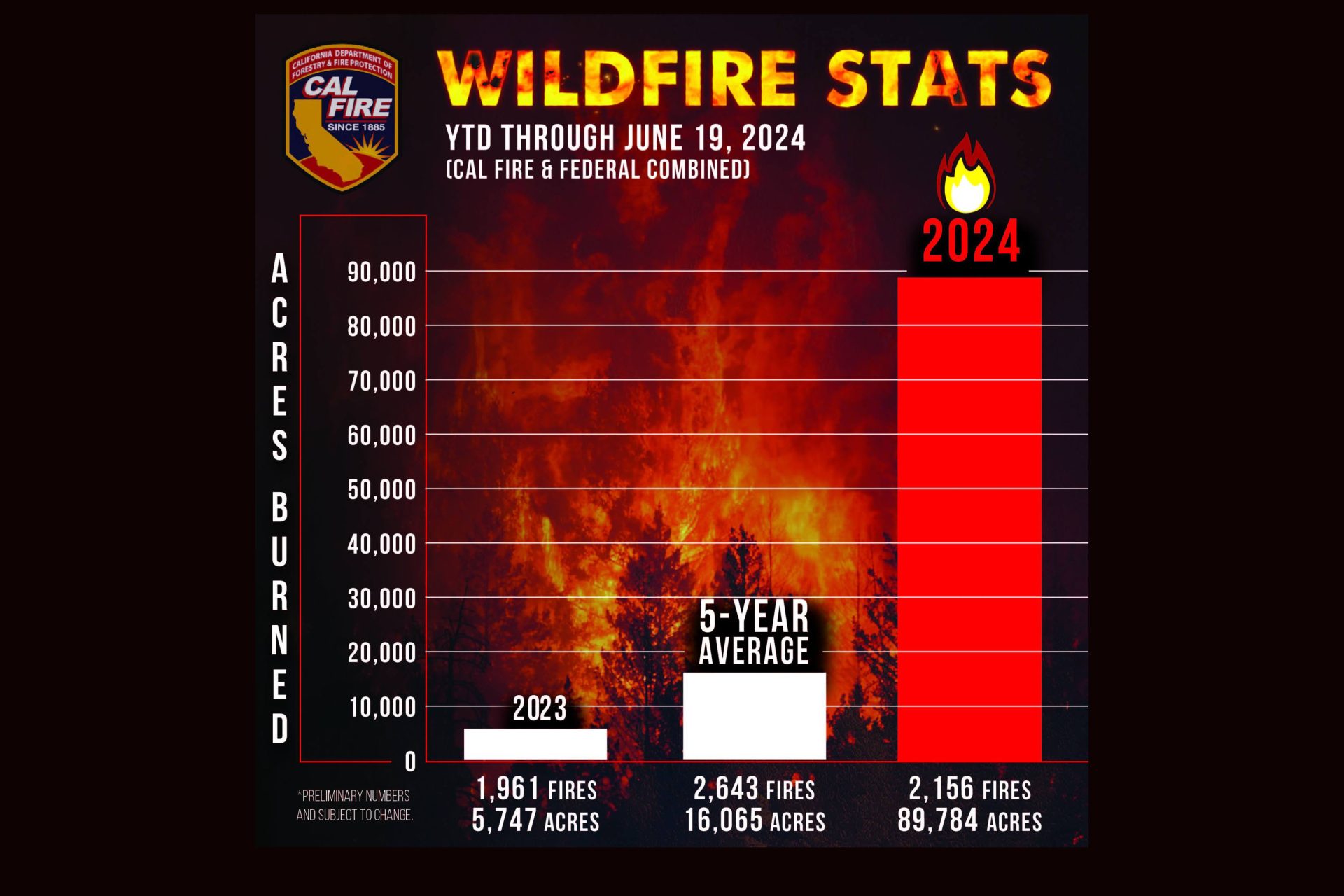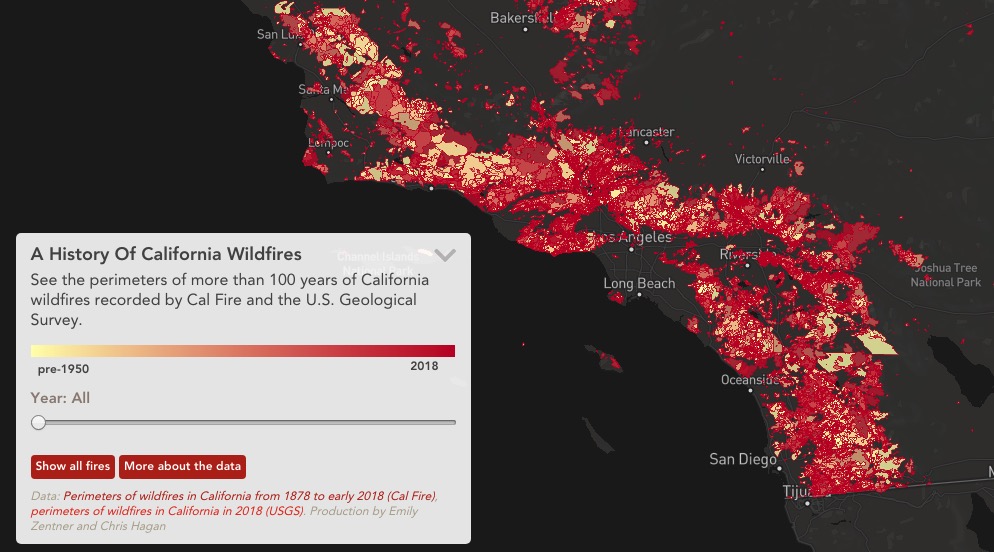Overview of July 2024 Wildfires
California has faced a staggering number of wildfires in 2024, with 4,521 incidents reported by the end of July. This alarming figure underscores the severity of the fire season and the challenges faced by firefighting agencies across the state. More details

These wildfires have collectively scorched 687,191 acres, leaving vast swathes of land charred and uninhabitable. The extensive damage to the landscape highlights the destructive power of these fires and the urgent need for effective fire management strategies.
When compared to the five-year average, the 2024 wildfire season has been particularly devastating. Both the number of wildfires and the total acreage burned have surpassed historical averages, indicating a worsening trend in wildfire activity.
The wildfires have not only ravaged the natural environment but also caused significant structural damage. A total of 188 structures have been destroyed, with an additional 58 structures sustaining damage. This loss of property has had a profound impact on affected communities.
Tragically, the 2024 wildfire season has also claimed a human life. The first and only reported fatality occurred in early July, underscoring the deadly potential of these fires and the importance of safety measures and timely evacuations. Read more about the impact

Details of the Park Fire
The Park Fire, which ignited on July 24, 2024, has spread across multiple counties, including Butte, Plumas, Shasta, and Tehama. The fire's location has posed significant challenges for firefighting efforts due to the varied terrain and the proximity to populated areas. Park Fire updates
As of July 29, 2024, the Park Fire has scorched a staggering 370,200 acres. This rapid expansion has been fueled by the region's dry conditions and the presence of heavy, receptive fuel beds, which have allowed the fire to grow uncontrollably.
Despite the relentless efforts of nearly 4,000 firefighters, the Park Fire is only 12% contained. The containment efforts have been hampered by the fire's rapid spread and the challenging weather conditions, including high temperatures and low humidity.
Currently, the Park Fire remains active, with ongoing firefighting efforts focused on containment and protecting threatened structures. The fire has already destroyed 66 structures and damaged five others, with thousands more at risk as the fire continues to burn. Firefighting efforts

Impact on Communities
The Park Fire has wreaked havoc on the region, destroying over 100 structures and damaging at least five others. The destruction has left many residents without homes and has significantly impacted local infrastructure.
In response to the rapidly spreading flames, thousands of residents have been evacuated from the affected areas. Emergency services have been working tirelessly to ensure the safety of those in the fire's path, coordinating evacuation efforts and providing shelter.
More than 3,800 people are currently under evacuation orders in Butte and Tehama counties. These orders have displaced families and individuals, forcing them to seek refuge in temporary shelters and with relatives in safer areas.
Despite the extensive damage and widespread evacuations, no fatalities have been reported from the Park Fire as of the latest updates. This is a testament to the effectiveness of the emergency response and the resilience of the affected communities.

Arson Investigation
Ronnie Dean Stout II, a 42-year-old resident of Chico, California, was apprehended by CAL FIRE arson investigators early Thursday morning. Stout is suspected of initiating the Park Fire, which has rapidly become one of the largest wildfires in California's history. Suspect arrested
Authorities allege that Stout pushed a burning car into a gully known as 'Alligator Hole' in Bidwell Park. The car descended approximately 60 feet down an embankment, igniting the surrounding vegetation and causing the Park Fire.
Following his arrest, Stout was charged with felony arson, with an enhancement for special circumstances due to his prior convictions. He is currently being held without bail at Butte County Jail, awaiting further legal proceedings.
Witnesses reported seeing Stout calmly leaving the scene after pushing the burning car into the gully. This critical eyewitness testimony has been instrumental in the ongoing investigation and subsequent charges against him.
Stout's criminal history includes two prior felony convictions: lewd or lascivious acts with a child under 14 in 2001 and robbery with great bodily injury in 2002. These convictions may significantly impact his sentencing under California's 'Three Strikes' law, which mandates severe penalties for repeat offenders.
Firefighting Efforts
Over 4,800 firefighters are currently engaged in battling the Park Fire, supported by 343 engines, 103 water tenders, 16 helicopters, and 160 dozers. This massive deployment underscores the severity of the fire and the extensive resources required to combat it effectively.
Firefighters are facing significant challenges due to the heavy fuel beds, high temperatures, and low humidity. These conditions are making it difficult to control the fire's spread and are putting additional strain on the firefighting teams.
Containment strategies include building direct containment lines and utilizing air tankers for fire suppression. These efforts are crucial in slowing the fire's advance and protecting vulnerable areas from further damage.
In addition to firefighting, teams are also focusing on evacuations and structure defense. Ensuring the safety of residents and protecting homes and other structures are top priorities as the fire continues to threaten populated areas.
Recent cooler temperatures and increased humidity have provided some relief, aiding firefighting efforts and leading to a slight increase in containment. These favorable weather conditions are helping to slow the fire's progress and improve the overall situation. Recent updates

Statistical Analysis
As of July 29, 2024, California has experienced 4,574 wildfires, which have collectively burned 726,667 acres. This marks a significant increase in both the number of fires and the total area affected compared to previous years.
In comparison, by the same date in 2023, there were 3,725 wildfires that burned a total of 25,554 acres. This stark difference highlights the severity of the 2024 fire season.
The five-year average for the same period stands at 4,377 wildfires burning 123,388 acres. This average underscores the unusual intensity of the 2024 fire season.
The increase in wildfire activity in 2024 is significant, with both the number of fires and the acres burned far exceeding the figures from the previous year and the five-year average. This trend raises concerns about the escalating impact of wildfires in the state.
Approximately 95% of wildfires in California are human-caused. This statistic emphasizes the critical need for public awareness and preventive measures to mitigate the risk of wildfires.

Historical Context
The worst year for wildfires in California was 2020, with 8,648 fires burning 4,304,379 acres. This unprecedented scale of destruction marked a significant point in the state's history, highlighting the growing threat of wildfires.
In recent years, the frequency and intensity of wildfires have increased due to climate change and other factors. Rising temperatures and prolonged droughts have created conditions that are more conducive to large, destructive fires.
The 2024 wildfire season is on track to be one of the most severe in recent history. As of July 28, 2024, a total of 4,521 wildfires have burned 687,191 acres, surpassing the five-year average for both the number of fires and acres burned.
The Park Fire, which started in July 2024, has become the sixth-largest wildfire in California history. It has burned over 370,000 acres, causing significant damage and highlighting the increasing severity of wildfires in the state.
The 2024 wildfires are part of a broader trend of increasing wildfire activity in California. This trend is driven by a combination of climate change, increased fuel loads, and other environmental factors, making wildfires more frequent and severe. Learn more about wildfire history

Praying for the California Wildfires
In times of crisis, prayer can offer comfort and hope. Here are specific topics and examples to guide your prayers for those affected by the California wildfires.
1. Praying for Safety and Protection
Example Prayer:
"Heavenly Father, we lift up the brave firefighters and first responders who are risking their lives to combat these wildfires. Protect them with Your divine shield and keep them safe from harm. We also pray for the residents who are in the path of the fires. Guard their homes and keep them safe, providing them with the means to evacuate swiftly and safely if necessary. Amen."
Explanation: This prayer focuses on seeking divine protection for those in immediate danger, including both the responders and the residents in affected areas. It acknowledges the bravery of firefighters and the vulnerability of residents.
2. Praying for Strength and Endurance
Example Prayer:
"Lord, we ask for Your strength and endurance to fill those who are fighting the wildfires. Give them the physical and mental stamina to carry on their difficult work. We also pray for those who have been evacuated, that You would grant them patience and resilience as they face the uncertainty and stress of displacement. Amen."
Explanation: This prayer seeks God's help in providing physical and emotional strength to those battling the fires and those displaced by them. It recognizes the physical and mental toll that such disasters can take on individuals and communities.
3. Praying for Comfort and Healing
Example Prayer:
"Dear God, we pray for comfort for all who have suffered loss during these wildfires. Surround them with Your love and provide them with the support they need during this challenging time. We also ask for Your healing touch for those who have been injured, that they may recover quickly and fully. Amen."
Explanation: This prayer aims to bring comfort to those who have experienced loss and healing to those who have been physically harmed. It highlights the emotional and physical needs of the victims, seeking solace and recovery.
4. Praying for Wisdom and Guidance
Example Prayer:
"Almighty God, we seek Your wisdom and guidance for the leaders and decision-makers who are coordinating the response to these wildfires. Grant them clarity and discernment as they make critical decisions. May those involved in the relief efforts act with compassion and efficiency, ensuring that help reaches those who need it most. Amen."
Explanation: This prayer asks for divine wisdom for leaders and those managing the crisis, ensuring they make the best possible decisions to mitigate the disaster. It emphasizes the importance of clear and compassionate leadership in effectively responding to such emergencies.
Prayer can be a powerful way to connect with those affected by the wildfires and to seek divine intervention in these trying times. For more personalized prayers and support, visit our Personalized Prayer Page.
Future Outlook
California is poised to introduce new policies aimed at enhancing wildfire management and prevention. These policies will focus on improving transparency in wildfire spending, ensuring equitable distribution of resources, and fostering better coordination among local, state, and federal agencies.
Technological advancements are revolutionizing firefighting capabilities. The integration of AI, drones, and IoT devices allows for early detection and real-time monitoring of wildfires, significantly improving response times and effectiveness in combating fires.
Community preparedness is becoming a focal point in wildfire management. Efforts are being made to educate and equip communities with the necessary tools and knowledge to enhance their resilience against wildfires, thereby reducing the overall impact on human lives and properties. Read more on wildfire management
Ecological forest restoration and controlled burns are being promoted as effective strategies to reduce wildfire risk. These practices help manage forest density and remove excess vegetation, thereby mitigating the intensity and spread of wildfires.
Addressing climate change remains crucial in mitigating the long-term risk of wildfires. Efforts to reduce greenhouse gas emissions and implement sustainable practices are essential in creating a more resilient environment capable of withstanding the increasing frequency and intensity of wildfires.

For personalized prayers and support, visit our Personalized Prayer Page and explore the features of our site on the Homepage.
